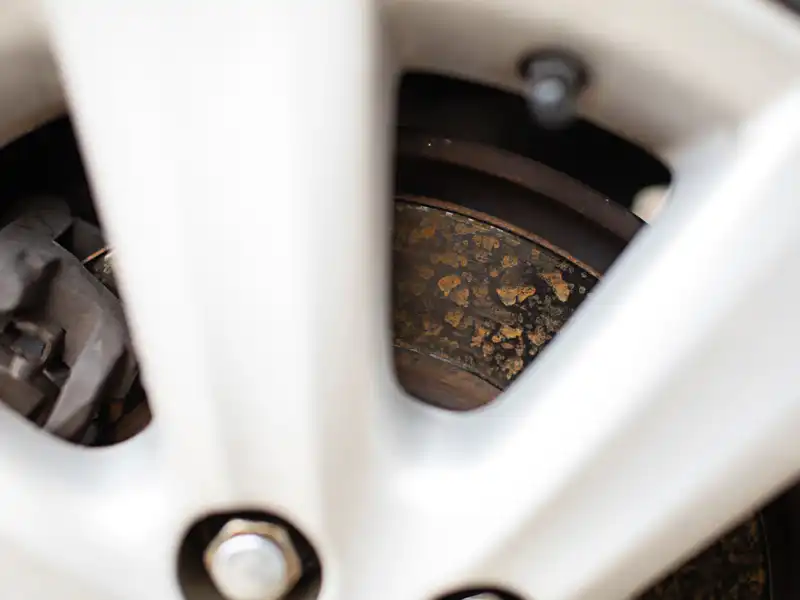Brake disc corrosion in a used car, is it a cause for concern?
Is corrosion on the brake disc in a used car a cause for concern? As always, everything depends on several factors.
In the article:
Brake disc corrosion
The brake disc rusts in these places most often
A commission shop ailment – rusty discs
When does corrosion become a problem?
How to protect yourself from corrosion?
At least once in their life, most drivers have seen a rusty coating on the brake disc in their car. A longer stop with more rainfall is enough. And in such a situation we can already observe surface oxidation of the metal. Is it always a cause for concern for the driver?

Brake disc corrosion
Brake discs are mainly made of cast iron. Therefore, their corrosion is a natural phenomenon caused by the properties of this material. The friction surfaces of the discs may become covered with a thin layer of rust, which, however, does not affect the operation of the brakes. During the first braking after a stop, this rust is usually removed, restoring the full functionality of the disc. The only thing that may reach our ears is increased friction, which should subside after a maximum of several brakings. Manufacturers of automotive parts use various methods to protect the discs from corrosion. This includes applying a layer of grease or oil, which is effective until they are installed.
The brake disc rusts in these places most often
Corrosion of the brake disc in a used car may appear on the edges of the element and its front surface. In these areas, there is no direct contact with the brake pad. Therefore, rust is not removed mechanically and may affect the aesthetics and generation of dust by the oxidizing material. If corrosion becomes advanced, it may cause blockage of the ventilation channels in the disc, which may cause it to overheat.
Some drivers decide to take action when they notice corrosion on the edges of the brake disc. Most often, one of the ideas is to try to manually or mechanically remove corrosion from the brake disc. Some used cars are of such low value that buying new discs and pads is a large investment. That is why people decide to sand down the rust on their own. However, it is important to remember that in this way we can easily damage the disc. First of all, it can cause its axial run-out when braking. Therefore, such activities should be approached with great caution.
A commission shop ailment – rusty discs
Brake disc corrosion in a used car is a common occurrence in car commission shops. Based on the degree of degradation of this component, you can theoretically estimate how much interest the vehicle enjoys. If the layer of rust on the discs is very large, the car is likely to attract moderate interest. Especially since it has not been tested.
Sometimes, the braking system is very old in collector cars. Especially in vintage cars that are not necessarily in laboratory conditions. In this situation, before the start of the season or a test drive, it is often necessary to invest in a new set of discs, pads and brake fluid.
When does corrosion become a problem?
Deeper corrosion that has penetrated the structure of the disc can cause rapid wear of the brake pads and even improper operation of the braking system. In such a case, it is necessary to replace the disc immediately. This is especially important in the case of cars that have been standing unused for a long time, for example in the aforementioned car dealerships.
How to protect yourself from corrosion?
The phenomenon of brake disc corrosion is becoming increasingly rare thanks to modern protection methods used by manufacturers. Some discs are coated with anti-corrosion paint, which provides long-term protection against corrosion, without requiring degreasing before assembly. Such methods are used by Rotinger, among others. It should be remembered that regular inspection of the condition of the discs, especially after a long standstill in damp or winter conditions, is crucial to maintaining them in good condition.
Brake disc corrosion is not always a cause for concern. It is crucial to understand when it is a natural phenomenon that does not affect safety, and when it poses a real threat to the operation of the braking system. Systematic inspection and maintenance are the best way to ensure that our car remains safe and efficient.
In the event that corrosion on the brake disc in a used car is so advanced that it is necessary to replace it, Rotinger has a rich portfolio of references. We can find components for most cars found on European roads.
Modern technologies used in the production process of Rotinger brake discs reduce metal oxidation to a maximum. Thanks to this, the only reason for changing the disc to a brand new one is its mechanical wear together with the brake pads.
All ROTINGER brake discs and drums are protected against corrosion with an innovative anti-corrosion coating! Check the offer!
Discover ROTINGER:
- brake discs – a wide range of discs for passenger cars and light commercial vehicles
- GRAPHIT LINE brake discs – a unique, patented technology for anti-corrosion protection of brake discs
- HIGH PERFORMANCE brake discs – a special line of High Carbon class discs
- BS LINE brake discs – a wide range of discs integrated with bearings for French cars
- TUNING brake discs – the widest offer on the tuning brake disc market
- brake pads – designed with safety and durability in mind
